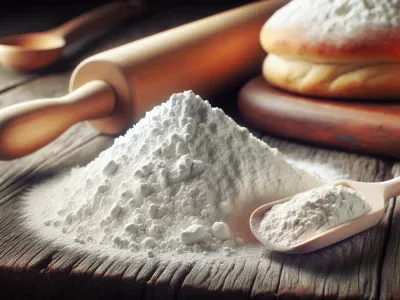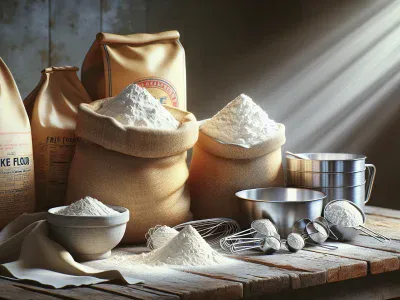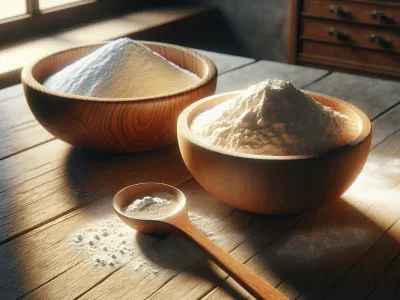Difference Between Bread Flour and All Purpose: Key Variations Every Baker Should Know
Picture the moment you pull a golden loaf from the oven—the crackling crust, the warm aroma swirling through your kitchen. But what if the secret to that perfect rise isn’t just your technique, but the very flour you choose? As you sift through the options on crowded grocery shelves, you might wonder why some recipes demand bread flour while others call for trusty all-purpose.
Unlocking the difference between these two flours could transform your baking from ordinary to extraordinary. Picture chewy bagels with a satisfying bite or feather-light rolls that melt in your mouth. The right flour doesn’t just change the texture—it can elevate flavor, structure, and even your confidence in the kitchen. Ready to discover how a simple ingredient swap can open up a world of possibilities for your homemade creations?
What Is Bread Flour?
Bread flour contains higher protein content than all-purpose flour, usually hovering around 12-14% according to King Arthur Baking Company. This protein, which you may have spotted on ingredient labels as gluten, acts as the framework for bread structure. Think about the difference between a pillow and a firm mattress—when you knead bread dough, protein strands stretch and form, giving the loaf its iconic chewy bite.
You might recall watching a baker stretch pizza dough without tearing it. The secret lies in bread flour’s gluten-building properties. If you’ve wondered why your homemade baguettes end up denser than bakery ones, you probably use all-purpose flour, because bread flour delivers the robust texture essential for crusty artisan loaves, pretzels, and cinnamon rolls.
Water binds with gluten-forming proteins, which then, with a bit of patience and kneading, trap carbon dioxide bubbles. This marvelous chain reaction means the dough rises tall, not wide. You may use bread flour for machine baking too—bread machines prefer its resilience.
Consider this: switching to bread flour can elevate your sourdough game, yet it might make cookies tough, because more gluten makes for chewier, less tender results. You get more elasticity in pizza crusts, but lose the softness in muffins.
Bread flour may sound like a single-ingredient game changer but it’s blended with malted barley flour and sometimes vitamin C to improve rise and shelf life (USDA). Are you ready to choose texture over tenderness, when you bake your next loaf?
What Is All Purpose Flour?
All-purpose flour acts as the backbone of many pantry shelves in American kitchens. It’s milled from a blend of hard and soft wheat, which gives it a medium protein content—typically 10-12%—according to the USDA and King Arthur Baking. Because of this balanced profile, you can bake chewy chocolate chip cookies, delicate pancakes, and even crusty bread with this single flour type. Did you ever whip up a batch of muffins and wonder why they were just right—not too dense or too crumbly? That’s all-purpose flour quietly doing it’s job.
When you scoop all-purpose flour, you’re selecting a versatile ingredient that works in various dishes. This flour’s moderate gluten-forming proteins means gluten formation is possible but not excessive. Southerners use it for biscuits that flake apart, while pizza enthusiasts find it forgiving for thin, crisp crusts. Cooks Report that all-purpose flour adapts when recipes call for either bread flour’s chew or pastry flour’s tenderness (Serious Eats, 2022).
Consider how cookbook authors always reach for all-purpose flour in classic American pie crusts. They discovered that stronger flours make pastry too tough, and weaker ones cause collapse. Betty Crocker’s test kitchens, for example, build their foundational recipes on all-purpose flour because of consistency in crumb and structure. While pastry chefs in Paris favor more specialized flours, home bakers across the US find all-purpose most forgiving and accessible. Have you ever tried swapping it for cake flour in an angel food cake? A denser, less airy cake answers that question.
You might ask—can a single ingredient do it all or does it weaken with specialization? All-purpose flour stands as a compromise, covering more ground than its counterparts but never excelling in just one. In your kitchen, this means tradeoffs. On the science side, its gluten content enables structure needed for bread, yet preserves tenderness in cookies and cakes. Enzymes and bleaching agents, sometimes used in commercial mixes, further alter loaf-rise and color, as noted by FDA labeling guidelines.
Question if you depend to much on one type of flour. Would your scones benefit from a softer protein profile, or your focaccia feel better with higher-protein bread flour? The answer shapes your kitchen adventures. That bag of all-purpose flour—quietly waiting on its shelf—embodies the balance between culinary curiosity and trusted results you bring to every recipe.
Key Differences Between Bread Flour and All Purpose
You’ll spot bread flour and all-purpose flour side by side on store shelves, but their differences in protein content and baking performance make each one unique. Knowing how these flours interact with key ingredients helps you control texture, structure, and final results.
Protein Content and Gluten Development
Bread flour contains 12–14% protein, while all-purpose flour averages 10–12% protein according to USDA data. That higher protein content in bread flour feeds gluten’s formation when you add water and knead. Gluten networks trap gases from yeast, which gives bread that chewy bite and tall rise seen in classic French boules or New York bagels.
All-purpose flour, with less protein, creates less gluten. You’ll notice pancakes and muffins baked with all-purpose have a softer crumb and spread less. Switching from bread flour to all-purpose in a yeasted recipe often leads to flatter, denser loaves.
| Flour Type | Protein Content | Gluten Development | Example Recipes |
|---|---|---|---|
| Bread Flour | 12–14% | High, strong, stretchy | Baguettes, pretzels, pizza |
| All-Purpose | 10–12% | Moderate, versatile | Cookies, cakes, pancakes |
Texture and Structure in Baked Goods
Bread flour’s higher protein makes kneaded doughs springy and elastic. Think about sourdough with a crunchy shell and a pillowy core—that’s the result of strong gluten strands. Challah, focaccia, and artisan loaves rely on this structure to create an ideal crumb.
All-purpose flour gives a tender, open crumb in quick breads, cakes, and pancakes. That means lighter scones, soft chocolate chip cookies, and spongy muffins. The difference becomes vivid if you’ve ever baked cookies that turn out rubbery instead of soft; it’s because bread flour built more gluten than the recipe needed.
Best Uses for Each Flour Type
Bread flour suits recipes demanding robust structure and chew. Pizza dough, French baguette, and cinnamon rolls each showcase bread flour’s characteristics: an elastic dough you can stretch thin without tearing, and a texture that withstands hearty fillings.
All-purpose flour adapts easily to almost any recipe calling for flour. Home bakers favor it for pie crusts, pancakes, muffins, drop biscuits, and even some sandwich breads. Try using bread flour for biscuits and you’ll often find them tougher than you’d like.
Diverse cuisines reflect these choices: Italian pizza makers insist on high-gluten flour for dough that stands up to wood-fired ovens, while classic American chocolate chip cookies rely on all-purpose flour for ideal spread and softness.
Selecting between bread flour and all-purpose flour impacts gluten development, crumb texture, and best end use for nearly every baked good.
How to Substitute Bread Flour and All Purpose Flour
Substituting bread flour and all-purpose flour alters the structure and texture of your baked goods. Each choice influences chew, rise, and crumb more than you might expect.
Adjusting for Texture and Rise
Swapping all-purpose flour for bread flour changes how gluten develops in dough recipes like pizza and dinner rolls. Bread flour contains more protein—so when you use it in a recipe calling for all-purpose, your dough traps extra air and water. This leads to stretchier crumbs in ciabatta or more resistance in focaccia. When using all-purpose flour in place of bread flour, less gluten forms, meaning sandwich bread turns out softer, sometimes denser.
Baking with all-purpose flour where bread flour is called for, try adding 1 or 2 teaspoons of vital wheat gluten per cup of all-purpose—this addition boosts protein, fixing the rise and chew missing from white sandwich loaves. Without this adjustment, the final bake may lack the chewy bite you expect from classic pizza crusts.
Tips for Successful Substitutions
Check your dough’s texture after mixing, not just the ingredient list. If kneading a bagel dough feels sticky using all-purpose flour, sprinkle in extra flour by the tablespoon. When substituting, reduce the liquid by around 1 tablespoon per cup of bread flour substituted, because bread flour absorb more water—according to King Arthur Flour experts. Watch rise times too; dough might ferment faster with all-purpose since it has fewer strong gluten strands holding it together.
Home bakers sometimes notice cookies spread wider if bread flour stands in for all-purpose, because its higher gluten resists collapsing less, asking you to chill the dough or bake at a lower temperature. For quick breads or muffins, you can swap one flour for another in a pinch, though you might notice a heartier crumb or extra resilience in the final bite.
Bread flour and all-purpose flour share a kitchen, but they shape each bake’s story differently—think of each as a script for the gluten network in your hands. Each substitution changes the lines; sometimes you get a standing ovation, sometimes you rewrite the scene.
Comparing Nutritional Values
Nutritional profiles for bread flour and all-purpose flour paint two distinct stories, almost like neighbors with different morning routines. Bread flour clocks in with a protein content between 12% and 14%, so, more of the muscle in the flour world. All-purpose flour, which hovers around 10% to 12% protein, brings flexibility like someone who does a bit of yoga but skips the bootcamp (USDA, 2023). If you peer deeper, carbohydrates dominate both, filling roughly 22g per ¼ cup serving. Fiber content rarely hits above 1g per serving, reminding you neither flour’s a fiber powerhouse.
| Flour Type | Protein (g) | Carbs (g) | Fiber (g) | Iron (mg) | Calories |
|---|---|---|---|---|---|
| Bread Flour | 4-5 | 22 | <1 | 1.2-1.5 | 110 |
| All-Purpose Flour | 3-4 | 22 | <1 | 1.1-1.4 | 110 |
Vitamin enrichment steps in as a subtle hero—both flours usually receive added iron, folic acid, and B vitamins as part of U.S. regulation. If you’ve ever noticed a richer taste in European bread, part of that comes from minimal fortification versus most U.S. flours. Malting and vitamin C sometimes find their way into bread flour bags, nudging dough to rise just a little higher.
Try to remember that switching flour types in recipes doesn’t just impact gluten strength or crumb—it can lightly adjust iron or vitamin levels in those cookies or waffles, too. Are you someone who prefers whole grains for micronutrients, or do texture and chew mean more to you? Even seasoned bakers occasionally reach for the wrong sack in the pantry, surprised afterward by a heartier loaf or a tougher cookie crumb.
Could your favorite sourdough have turned out differently just with a swap of bread flour for all-purpose? Nutrition meets chemistry every time water hits flour, building networks that make or break a pâte fermentée or a simple pancake. Consider which matters most for you, seeking balance or specialty: each time you bake, you’re not just shaping dough—you’re reshaping nutrition, tradition, and maybe even your next family memory.
Which Flour Should You Choose?
Choosing the right flour transforms more than just your recipe—it shapes your entire baking story. Bread flour and all-purpose flour offer semantic tension, like two actors cast for different but equally vivid roles in your culinary narrative.
Picture pulling hand-shaped baguettes, their crusts crackling, from a sunlit oven—protein-rich bread flour, clocking in at 13%, (USDA, 2021) forms an elastic dough that demands kneading like a dancer stretching before a show. Stand in the kitchen at midnight, craving chewy pizza, and bread flour bridges the gap between common craving and bakery perfection. But say you pivot: grandma’s favorite chocolate chip cookies call for tenderness, not tenacity. Here, all-purpose flour—your kitchen’s steady protagonist—steps in, its moderate 10% to 11% protein yielding tender, golden cookies, lofty pancakes, and buttery muffins (King Arthur Baking Company).
You ever wondered why some loaves rise like castles while others slump like forgotten dreams? Gluten networks, built from protein, create a lattice—a bread flour lattice rises strong and tall. Yet, stretch that same lattice into pancakes, it breaks harmony; chewiness overwhelms. All-purpose flour adapts, blending hard and soft wheat’s attributes, swinging between rustic bread and delicate pastries with fluid grace.
So your choice hangs on scene and character: Are you baking airy focaccia or crispy cookies? Is your audience after a hearty crunch or soft crumb? Those who chase the perfect sandwich loaf, wield bread flour and coax extra elasticity by adding vital wheat gluten or a touch more water. Seekers of simplicity wield all-purpose flour for fuss-free batters and classic cakes, trusting its balance to carry them through.
Sometimes, you might even rebel against the script. Some home bakers swap flours to experiment, accepting a denser sandwich bread or a chewier brownie, crafting hybrid delights that defy easy categorization. Did anyone ever say there’s only one right answer in bread’s labyrinthine world?
Nutritional data may sway your decision—bread flour pulls ahead in protein by 2-3 grams per cup; all-purpose flour clings close in calories but offers broader application for everyday dishes (USDA, 2021). Consider your goals: More protein for structure or versatility for exploration? Each flour brings a distinct voice to your creation.
What will your next bake say about you—ambitious or approachable, classic or boundary-pushing? It’s your kitchen; the plot’s in your hands.
Conclusion
When you understand the unique strengths of bread flour and all-purpose flour, you unlock new possibilities in your baking. The flour you choose becomes a tool for creativity, allowing you to craft everything from chewy artisan loaves to tender cookies with confidence.
Let your baking goals guide your flour selection and don’t hesitate to experiment. Every batch you make is a chance to refine your skills and discover the textures and flavors you love most. Your flour choice isn’t just about following a recipe—it’s about shaping your own baking journey.
- Which Is Best: Computer Science or Information Technology? - November 12, 2025
- Airbnb Pros and Cons - November 12, 2025
- Rye Versus Bourbon: Understanding the Key Differences - November 12, 2025







